Walking paper horses are so cool and all over social media right now!
Cool-ology® Kids- here’s how to make one!
You will need:
- A sheet of paper (heavy paper like construction or card stock work best)
- Scissors
- A pencil
- A ruler
- Foam Poster Board
- Books or a box- 71/2” – 12” high or more. You can experiment with the height of the angle to figure out what works best.
What To Do:
1. On a piece of heavy paper or card stock, draw the following dimensions: Top and bottom edges: 3 5 cm sections (15 cm total). Side edges 3 1.5 cm sections (4.5 cm total). To all four corners, measure 0.3 cm triangles. Take a look at the diagram for details:
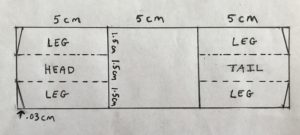
2. Cut the rectangle around the perimeter of your template. Cut the dotted lines on the outside squares up to the center square. Cut the tiny triangles off of the 4 corners making sure they are all even.

3. Bend the “legs”- all four outer rectangles- so they are perpendicular to the body.
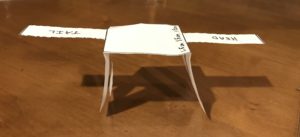
4. Fold the “tail” up. Curl it a bit using the corner of a table or the straight edge of scissors.
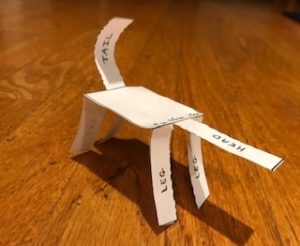
5. Fold the “head” up. Fold about 1″ of the “head” down and shape into a triangle. Cut little ears if you want.
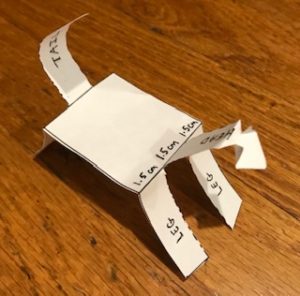
6. Place your foam poster board on a stack of books or a box (experimenting with the angle to see what works best).
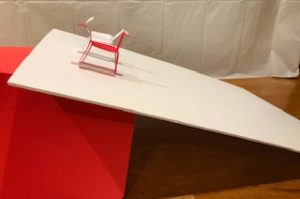
7. Give your horse a little push. This may take many attempts. You may need to adjust the head and tail up and/or down for balance. You may need to cut the triangles in the feet a bit more or curve them a little. Experiment!
The PHYSICS behind the Walking Horse:
At the top of the hill, the horse has lots of POTENTIAL ENERGY. When given a push, GRAVITY pulls the horse down the hill, turning the POTENTIAL ENERGY into KINETIC ENERGY. The horse wobbles back and forth, gaining MOMENTUM as it moves. Did you notice that if your horse gains too much momentum it just slides down your ramp? Too little gravity results in your horse stopping before it reaches the bottom of your ramp.
FRICTION plays a part in how fast, how well, your horse moves. Try adding something with more friction to your poster board (for example: felt or a carpet square). Now try adding something to your poster board with less friction (aluminum foil or plastic wrap). Will your horse move down a ramp made of cardboard? Try it!
The MATH behind the Walking Horse:
The horse itself is made of shapes and angles. Adjusting its geometric parameters even a little bit can add to your success. The ramp can (and should) be moved up and down as you test your horse. Experiment by adding or taking away height and changing the angle for mastery!
You must measure accurately to create your horse. Using a ruler correctly is doing math- yay!
Can you ENGINEER a different animal to get the same result? What about adjusting the horse so it moves faster or slower?
Above all, DON’T GIVE UP!! This activity takes a lot of tweaking and perseverance. Try making little adjustments and move past any feelings of frustration. It’s so amazing when it works! Have fun!!

